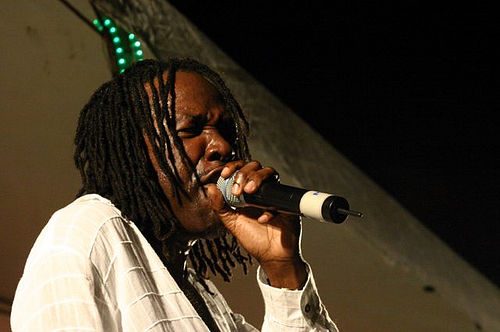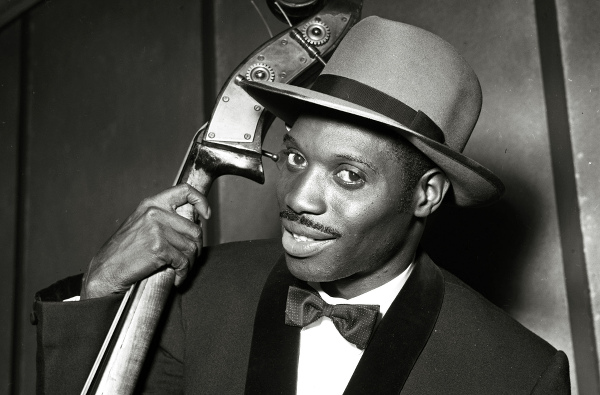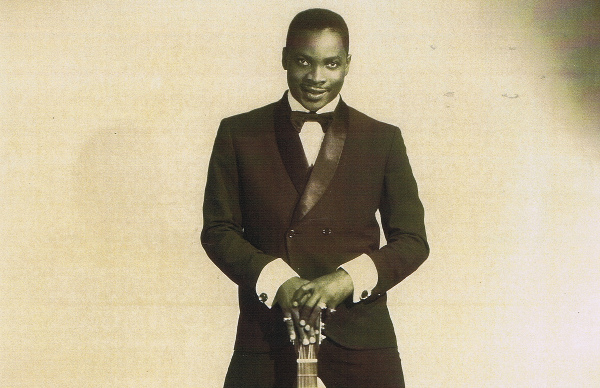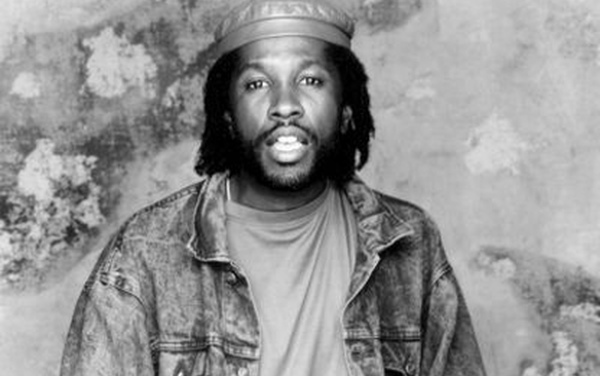Fitzroy Coleman fingers dancing on the fret. And when you think that he through, he aint start nothing yet‚Ķ¬Ý
“Calypso Music”, David Rudder

While Rudder‚Äôs lyrics are now a clich√©d reference to the jazz/calypso guitar great, it is Fitzroy Haynes Coleman‚Äôs saviour from obscurity in the land he was born in, that shaped his style, and failed him terribly.¬ÝThe few videos available of Coleman at work capture the sweet chromatic chaos and the intricate, complex choreography that he performed every time he picked up the instrument.
His fingers stretch to form personalized chords and voicings, while his thumb does the tango to pivot his fingers into unimaginable positions and sounds on the fret board.¬ÝThe chords and licks that made him famous are the innovations and inventions of a young boy with perfect pitch, who, from 1932, stole alone-time with his father‚Äôs precious guitar when that gentleman was at work.
Performing almost like a minstrel with other youth for the estate owners of St Clair earned him the nickname ‚ÄúLittle Boy Wonder‚Äù, which led him to England in 1945 with an all-star Caribbean band. He was chosen above experienced guitarists who read music. At the time he couldn’t.
Throughout the 1950s, he was constantly rated among the best guitarists in Europe. He created jingles for Barclays Bank. Being black then, Coleman said, was a hindrance to landing big gigs and recognition. By the mid-1950s, his performing in excelsis could not go unnoticed. He was frequently featured on BBC radio, and television broadcasts. He accompanied Mahalia Jackson, Lena Horne, Marlene Dietrich, Tony Bennett and many other international stars.

(Courtesy Jacqueline Morris)
Coleman and Kitch: Race and Love
No doubt his guitar work played heavily on Kitchener’s pre-soca sounds of the 1950s and 60s. Coleman once said that he and Kitchener were friendly before he left for England. When his calypsonian friend arrived in 1948, they would improvise music and lyrics in their performances, trading and feeding off mutual respect and brilliance.
Although musically and lyrically Kitchener may not be remembered for socially conscious songs, early Kitch was different. He was at the forefront of building West Indian identity among burgeoning immigrant communities in England. Fitzroy Coleman was his right-hand man in composing and recording the sounds and stories of black West Indian immigrants in the UK.
Coleman‚Äôs chords and colours are clearly heard in the important social chronicles such as¬Ý‚ÄúWhen a Man is Poor‚Äù¬Ýand¬Ý‚ÄúIf You‚Äôre Brown‚Äù. Without his melancholic tones, the social commentaries of the tribulations of the Windrush Generation would have been far less impactful. At the time, he also worked with and helped Lord Beginner and the Mighty Terror find their feet in a new country. (Coleman‚Äôs solo in¬ÝThe Monkey¬Ýis a lesson in instrumental soloing for calypso).
In England, he gigged at every club, restaurant and hotel imaginable. The performances were organized by his friend Enid who had owned nightclubs before World War II. In an interview on Power 102FM this week, Foster said she always took diligent care of his business. Tricky fellow musicians took advantage of the island boy in the “mother land” metropole until she came along.

(Copyright Colin Dunn)
One day, Foster¬Ýsays, Enid asked Coleman, ‚ÄúWhy don‚Äôt you marry me and let me take care of your business?‚Äù Coleman and Enid got married in 1947. She had told him she was ten years older than he was; it was more like twenty. When she died, he discovered the truth.
Whatever the state of their love, her professional care for him lasted late into Coleman’s old age, as he used to receive pension cheques from England before he died.
She defended him and strongly opposed anyone who had anything to say about his colour. Foster relates a story of the couple walking the streets in London one day when someone called him a nigger. Enid said to Coleman, “Darling, wait here.” She walked to the taunter and said: “You didn’t know they were niggers when they were fighting for us in the war!” She beat him up.
The flawed genius
As a young reporter and musician, I once tried to interview him. For years, I had researched his music. I picked up the telephone directory, found his name and gave him a call. His second wife, Edna, who he lived with in Laventille answered the phone. She called him and he sounded excited that a youngster knew of him and wanted to talk. I got there a few minutes late and called at the gate. He chased me furiously, warning me never to come back. Discouraged, I never tried again.

“Like most geniuses, he was very fragile,” Foster tries to piece together some of the experiences that made the genius such an emotional man. He explains that Coleman frequently remitted money to his mother while he was in England.
On a visit to Trinidad in 1960, he was very upset to see his mother still living in a dirt-floored Woodbrook barrack yard, with alcohol a key part of her existence.
Older musicians ostracized him when he left Trinidad. They were jealous that a young man, who, at the time, could not read music, was taking their place to go to England in search of a musical living.
He learned to read and began to learn the theory of the things he had already been doing on the guitar without being taught. The rejection he faced from some of his own countrymen continued in England.
His return to Trinidad to play music was difficult. In response to his style in Kitchener’s Frederick Street tent, he got: “Mr. Coleman, you bound to make all them chords?” And: “You playing rubbish! We don’t want no Englishman here!”
That led him to self-imposed exile in the Matura forest. He bought ten acres of land and began to garden. Music was a thing of his past.

Lord Relator, one of his guitar students says, ‚ÄúKitchener would dig what he was doing. It was like school for me. Men couldn‚Äôt relate. They would look back like he playing s–t, when he played a 13th or a flatted 5th. He fattened the chords.‚Äù
Mas’ man Teddy Pinheiro, a fabulous collector and archivist of cultural trinkets and records, says in one musical lime decades ago, Coleman picked up Relator’s guitar and played all sorts of songs for forty minutes. After, Relator exclaimed, “Ah never hear my guitar sound so good!”
Coleman the experimenter
As an innovator, he is unmatched. He would take bass guitar and banjo strings and put them on his guitar. One of the recordings sounds like he was using synthesizing technology which did not appear until the decades of the 80s and 90s.
Foster chronicles some of the work of the intense innovator and says that Coleman had written countless chords that he imagined in his head onto paper.
“It took him two years to perfect a chord.” Foster says that John Williams, recognized as one of the greatest classical guitarists ever, once looked on in tremendous respect at Coleman playing. He said Coleman was “the world’s greatest chord-player.”
His chordal playing is unlike anything heard before or since. Sometimes, he would play a separate chord for every note of a bass line (which he played), walking a mile a minute, cajoling from unsuspecting ears, the impression of two or three guitars, all while he played intricate melodies.
In much of his calypso soloing, the sound is rooted in a Trinidadian joie de vivre. Brief solos, peeping from behind calypsonians‚Äô lyrics are high craft, fast and sweet. Listen to Roaring Lion‚Äôs¬Ý‚ÄúMary Ann‚Äù.¬ÝAfter a chorus, Lion‚Äôs lyrics instruct him to ‚ÄúCome up, Mr Coleman!‚Äù He lets rip a fast, high-pitched barrage of demisemiquavers and semiquavers, rattling the frets.

Pinheiro, Relator and Foster relate the story of Coleman playing in a band assembled by Sparrow, and being fired because his soloing sorcery was stealing the limelight from the Calypso King of the World.
What can be done to preserve, beyond Rudder’s words, the already frail legend of Fitzroy Coleman? UWI and UTT researchers should compile a detailed discography.
The archives of Pinheiro (with his direction and blessing) should be made an important part of every library’s heritage section.
Relator’s chords, handed to him by Fitzroy Coleman must be written and taught in fine arts programmes at UTT. Foster should be given the funding and support to make his recordings of Coleman into a documentary. These are just a few suggestions.
I have no regrets. The thing is, I’ve made a lot of people happy in this world, and I contribute to mankind. As far as I’m concerned, if I close my eyes now, I didn’t waste my life. I’ve done something constructive for mankind. That’s how I look at it.
Fitzroy Haynes Coleman 1923-2016
Jabari Fraser is a journalist and broadcaster. Over the last 14 years, he has worked in media, as a foreign language interpreter and teacher, and as a development communications specialist around the Caribbean.
 Wired868 Wired868 for smart sport news and opinion
Wired868 Wired868 for smart sport news and opinion







Good things to remember music is fruit of life so lets live on,hits also our instrument of life,it lift up our life,it inspire our life ,it will always live on,whether is piano,pan,guiater,trumbone,flute,drums,whatever lets make it a part of oue lives is beautiful italien lifts your spirit
Everybody has a story of their encounter with Fitzroy Coleman. Mine was one that captured his anger at the society that he came back to, but also captured his amazing generosity as he let two “stormers” enter his home and talk and play guitar with him. The late Ben Richards of Benny’s Swim World, an avid guitarist and jazz picker just so, on a vaps, said let’s go up Laventille by Fitzroy’s home to ask him for some chords. We knew Ewart Serrant was a “student” of the master and Ewart told us about Fitzroy having hundreds of songs with chord progressions no one else was using. So see us two, go up the road and reach his house and calling his name from the gate. His wife came out first, we said we were on a mission. He came out, and we sat on his gallery. We knew he would have to ease him into a conversation, so we asked the obvious, “What was the music scene like for Caribbean musicians in London in the 1950s?” An hour of stories and anecdotes and memories. Stupid us, we had no tape recorder! We heard about Melodisc Records and we heard about his relationship with Kitchener. It was not good! He even said he stopped playing the guitar and he was a farmer. His guitar, a Boosey & Hawkes purchase, was under his bed, un-played for a year!
So an hour later and Ben still holding his guitar meekly, but we know we can’t play a note until he say so, so finally Ben showed the master his chops playing for Fitzroy the Mickey Baker progressions he learned. Fitzroy say, “that nice, but let me show you what I hear when I listen to the song,” a local Christmas song. The man play a jazz parang, melody, harmony, rhythm in two minutes that went up and down the fret board. He hands back the guitar to Ben who then puts it away knowing that the guitar had never been played so beautifully, and it would insult the atmosphere if he played it after that. Jaw on ground! He generously gave us chords for two songs, Errol Garner’s “Misty” and Jobim’s “One Note Samba.” I still have the chords he called out:
||: A13 / DM9 / | DM9 / Am9 / | D13 D7 G GM7/6 |…….. (Misty)
Try and play that and do a six-fret finger stretch. Fitzroy could, and with ease after a self-described hiatus from his instrument. We were in awe as we went back down to the city. This was the lament of a man who was hurt and bitter. Reading David Michael Samuel Rudder’s post, he was also used. Old men were prey. Lion. Kitch.
The curating of a legacy was left to individuals like Robin and Martin, and Gayelle. State intervention, always too late, is a norm in the Caribbean. We owe this man’s legacy better respect as he put us on the music map in the UK as musicians worthy of accolade and commercial partnership. Beyond the existance of an indifferent state apparatus, we must do it ourselves, and this essay serves as an inspiration to cultural entrepreneurs of how to revere worthy music heroes.
thanks for the information. I am always overwhelmed when I read such articles about icons in T&T. We do not fully appreciate the blessing that God has given to us as a people. Whether it be Spanish, French English, Dutch, Chines , Syrian, indigenous peoples. We are a unique people with unique sounds, but we take it for granted. MR Coleman was indeed blessed like so many others in his own way,but treated like so many other greats of the land, with disdain and disrespect. s I’m in my 50s and will admit I know not much about Mr Coleman, but here we go again , another icon departed and we saying the same things. A son of the soil appreciated abroad but not home. Trinidadians, don’t like change , don’t’ appreciate difference, envy and jealousy. Instead of seeing it as an opportunity to be exposed to something new, No one takes the responsibility or there are no labourers in the vineyard willing to do the work. We wait on the government who have their own agenda. There are young people who are like me dont’ know suhc persons, since it is not document anywhere. the removal from history in school has added to the problem. Is there a book which compiles deceased artistes anywhere in T&T. How are young people to know about the past music so they can appreciate where the music is at currently. How can they be exposed to such brilliance and expertise. Although he could not read the music,he had a gift from God, to simply hear and play. Its the same story today, go abroad and when you return home, you have to fight to impart what one has learnt, so frustration forces you to go abroad to make a living Why wait on UWI and UTT to do research. Politics comes into play and nothing is done. I’m not getting racist here, but East Indian have their own Museum at the Divali Nagar and research their icons etc. With Africans its the Lloyd Best “crab in a barrel”syndrome. Why can’t people in the music industry get together and do something. Why is it we dont’ have an Institute with people doing research,( do you know how difficult it is to study local people, since there is a lack of information, instead we have to settle for foreigners writng about locals) people like video artiste, writers, editors etc should be compiling the works of our champions.(not government funded,because then it becomes politiicsed) Icons are dying and the wealth of information dying with them. I stress we doing the same thing over and over and going nowhere.Also many of the top so call culture people, employed by successive governments, simply fill their pockets, charging huge sums for consultancy work, while bad mouthing each other and in the end’simply ‘eating a food’ and doing nothing. Another one bites the dust. So many artiste has gone and where are their works, PS this is not only about musicians, Calypsonians, pannist, but historians, writers, politicians etc. We simply don’t care
Excellent article thanks
That very night at De Luxe, he lamented that he couldn’t pass on recorded knowledge for further generations. ” Plenty people promise, but they never followed up” he said.
I didn’t say anything, but I had a talk with several musicians and a recording studio. They excitedly all agreed and all that was left was Mr Coleman’s blessing. I was supposed to go to his home with Wayne Bruno the following day to let him know that the recording sessions were set. That morning, bright and early I’m looking through the Express and I see the heading ” Fitzroy Coleman signs with Eddie Grant.” I read on and I see at the end of the article he made the point of saying that he wasn’t talking to anyone and if anyone wishes to speak to him, they should call his manager Eddie Grant.
Project crash right deh.
Thanks for your comments, Michael Samuel. If it weren’t for that line, he would really have been totally forgotten.
Welcome.
Jabari Peter Bem Fraser True. Sad.
I got to meet Mr. Coleman about 10 years ago thanks to Robin Foster who was doing a project to preserve his legacy. We spent some time at his home in Morvant interviewing and recording him. He spoke very little about music actually. What stuck in my head was what he had to say about the music business. At first, what said sounded a bit like some wacky conspiracy theory: a lot about how record labels use drugs to control their stars and use them and discard them like old rags. He named a LOT of names. Many famous, even household ones I won’t repeat here. He said this was one of the main reasons he got disillusioned and left the UK. I took what he said with a pinch of salt. Then in early 2011 I got a call to work on a session with a major international artist in a studio abroad. The session suffered postponement after postponement with the artist apologising every time. The artist spoke about how they felt trapped and were trying to get out of certain situations, The session was eventually cancelled. Not long after, the artist died of a drug overdose and everything Fitzroy Coleman said suddenly made perfect sense…
Very interesting, Martin Raymond . It’d be great to hear some more about your interaction with him.
He once told me backstage at the then De Luxe cinema. “Young man, I old now, but when I was young, these fingers used to fly.”
Thing is, his fingers were flying that night, but he didn’t think so.
I missed his era. Where can I find his music? Rubadiri Victor?
It is difficult but not impossible to find recordings of our greats in London from that era. There was a compilation album whose name I can’t recall offhand. Will check and get back to you.
Wonderful read. Thank you.
I did a long and pretty comprensive interview with Fitzroy for over 2 days but lost it when the recorder was stolen soon after. Thankfully Robin Foster faithfully recorded his biography audio visually. What I do have is a series of dozens of photographs I commissioned with my friend Trini-Hollywood photographer Dexter Browne which elevate Fitzroy to his proper height as Demi-god and which could grace any international magazine cover. Both things were done as part of Project MEMORY- my project documenting Elders. Also important to note is that Sean Thomas was a caretaker for Fitzroy in the later years, locating and collecting royalties Fitzroy did not know existed and making sure he was paid. Sean would buy groceries etc and take care of the family. Salute Sean!!! Sean honoured Fitzroy at one of his Jazz galas 4 years ago- something Fitroy really appreciated. I won a Cabinet decision to record and publish Fitzroy’s biography amongst 10 Icon artist biographies (Sparrow, Sundar, Kitch, Beryl included) alongside the commissioning of 10 histories of our art forms- The History of T&T Dance, Hosay, Ramleela, Soca etc. All the authors redoubled work on these historic coffee table books- and government has not released the money up to three years later…
Well, please know that you can use Wired868’s platform if you wish to draw attention to any of those issues.
And God bless you Sean! Lol. Also maybe I can asked Dexter what it would cost to buy one of his photos to use with this story. Strictly online use.
If he does agree please credit the photo to him and with: Image used courtesy Project MEMORY. Watermarked.
Well written. The world lost dozens of new chords when Fitzroy died and we were uninterested. One of the greatest ever and we threw him away like all our best. There will come a time soon when we will look back at this period of Giants- just like this period of oil and gas- and wonder how we squandered it all…
Well said